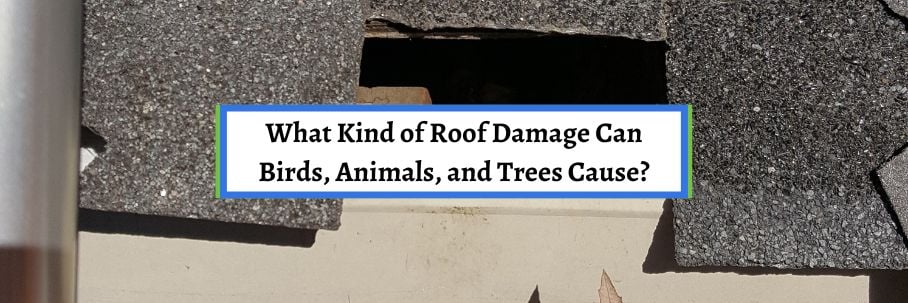The last thing you want to hear is pitter-patter on your ceiling. Not only does it mean you have animals in your attic, but they got in there through something.
Unfortunately, the access point is usually through or around the roof. And it’s not just animals you have to worry about; birds, insects, and trees also cause plenty of roof damage.
But how do these things damage your roof? Can you prevent it from happening in the first place?
For over 30 years, the team at Bill Ragan Roofing has helped homeowners understand what causes roof damage and how it affects their home. That’s why I want to break down how critters and trees cause damage to both your roof and home.
By the end of this article, you’ll have the answers to the following questions:
- What kind of roof damage do birds cause?
- What kind of roof damage do animals and insects cause?
- What kind of roof damage do trees above or around your home cause?
- How do you prevent birds, animals, and trees from damaging your roof?
What kind of roof damage do birds cause?
Birds are often overlooked, but they can cause some pretty serious roof damage. The damage they cause isn’t even necessarily them destroying your roof to access your attic space.
Instead, the damage they cause comes from their droppings and building their nests.
Acidic bird droppings
Bird droppings are highly acidic, and constant exposure can literally eat away at roofing components. This is especially true for tar-based materials and components, like asphalt shingles.
Research has shown bird droppings can shorten a roof’s lifespan the more it’s exposed to them. While shortening your roof’s lifespan is bad enough, it also makes your home vulnerable to damaging leaks.
Nests causing drainage issues
Gutters are popular places for birds to build their nests. Unfortunately, these nests create blockages that cause water to get behind your gutters or back up on the roof.
Even worse, the pooling water sits on a material that isn’t meant to handle it. This eventually leads to water getting underneath your roofing materials, causing leaks and other issues such as mold, mildew, and wood rot.
Fire risk from flammable materials
Clogged gutters and drain pipes aren’t the only issues that bird nests can cause. The straw, leaves, sticks, and dried bird droppings in nests are highly flammable.
This is something you definitely have to worry about if the nests are near or in machinery on your roof, such as HVAC units. Nests built in chimneys, HVAC units, or ventilation systems can also create dangerous airflow blockages that could potentially be lethal.
What kind of roof damage do animals and insects cause?
Birds are one thing, but other animals and insects can actually be destructive. And they don’t just damage your roof but also put your home and your family’s health at risk.
Creating roof damage to access your attic
Your attic is the perfect home for many small animals and insects to stay safe and warm. Unfortunately, they get into your attic through a crack in a roof vent or they’ll create an opening in your roof.
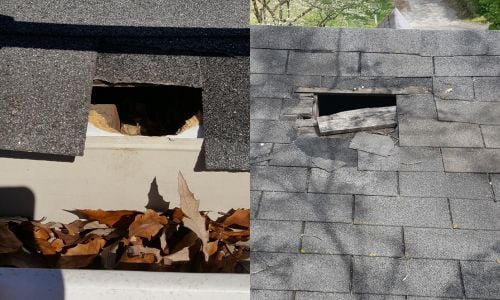
Once they access your attic, they can create leaks by chewing through your shingles, siding, and trimming. They’ll chew through more and more of your roof’s protective layers the longer they’re in your home, making it vulnerable to water damage and dangerous mold.
Fire and biohazard risk
There’s also a fire risk that comes with animals in the attic chewing on things like electrical wiring in your attic or running through your roof. This puts your home in harm's way at any given moment with small animals in your attic.
Chewing is one thing, but animals also create a huge health risk with their droppings. The longer the animals go undetected, the more waste they produce that leads to potential health problems.
Termite infestation in a poorly ventilated attic
An improperly ventilated attic creates the perfect place for termites due to excess moisture. A termite infestation in your attic causes significant damage to your roof’s decking, rafters, and other wooden structures.
And once they’re done with the attic, they’ll spread to the rest of your home. While a termite infestation is bad enough, improper attic ventilation also drastically shortens your roof’s lifespan.
What kind of roof damage do trees above or around your home cause?
Trees obviously attract birds, which leads to potential damage caused by the acidic droppings if the limbs hang over your roof. However, trees overhanging or around your roof can cause even more problems.
Leaks caused by drainage issues
Trees around your home create debris piles on a roof from fallen leaves, sticks, seedlings, etc. The problem is that this sitting debris stays saturated, which damages the material underneath.
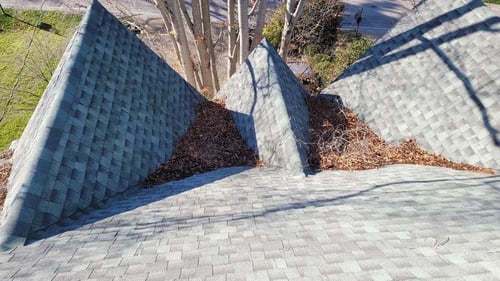
While sitting debris alone creates issues, there’s also a huge problem if a dam forms from debris build up in roof valleys. This causes water to back up the valley before it eventually finds the path of least resistance to leak into your home’s interior.
Overhanging tree limbs eroding asphalt shingles
Bird droppings from overhanging limbs are one thing you have to worry about, but they also cause continuous drips of water when it rains. This constant dripping erodes the protective layer of asphalt shingles over time, which shortens their lifespan.
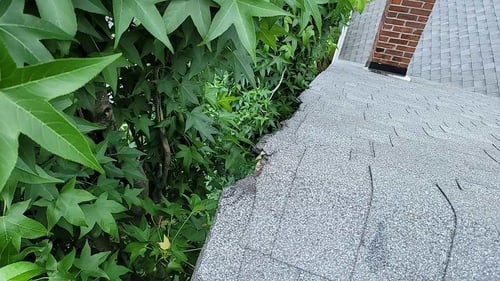
While you have to worry about what’s coming off the tree limbs, another problem is when the limbs are actually touching your roof. The constant rubbing between the limb and asphalt shingles damages them beyond repair.
Structural damage
The most obvious roof damage a tree or a tree limb can cause is when it physically falls on your roof. A single fallen tree limb can go through a roof, so an entire tree falling is likely cause significant structural damage.
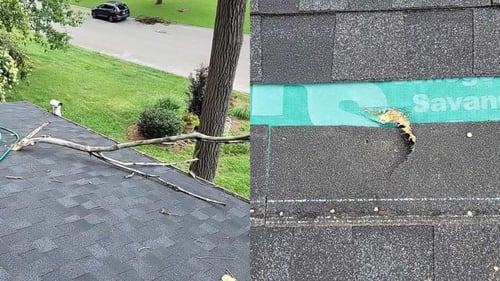
However, there are cases when a tree falls on a roof without going through it. This may not cause structural issues but will still damage your roofing material and components.
That’s why it’s a good idea to call a roofer to assess the situation, even if a fallen tree or tree limb doesn’t go through your roof.
How do you prevent birds, animals, and trees from damaging your roof?
Now you know the kind of roof damage birds, animals, and trees cause. But how do you prevent this damage from happening in the first place?
Let’s look at three ways to prevent the kind of roof damage we covered in this article.
Early detection is key
When it comes to animals or insects damaging your roof, early detection is the solution. A roofing contractor can repair roof damage caused by animals and insects, but you’ll have to call an extermination company to get rid of the actual problem.
The important thing is to evict all pests and/or rodents before there’s permanent costly damage.
Keep your tree limbs trimmed
For tree damage, the best thing you can do is completely remove the tree(s) around your home if you really want to avoid it altogether. However, removing trees is expensive, and some homeowners like trees on their property.
If you don’t want to remove the tree, the next best thing is trimming your tree limbs back. This ensures they no longer hang directly over or touch your roof, which prevents erosion, rubbing, and structural damage.
Getting routine roof maintenance
The best way to prevent the roof damage we’ve covered is by getting roof maintenance from a local roofing company. Getting roof maintenance catches problems caused by birds, animals, and trees before they get out of hand.
The roofer could even see the early signs of potential damage and make recommendations to prevent it from happening altogether. Roof maintenance saves you money, prevents future problems, maximizes your roof’s life, and gives you peace of mind.
That’s why I recommend getting your roof inspected at least once a year.
Will insurance cover roof damage caused by animals, insects, and trees?
After reading this article, you now know what kind of damage animals, insects, and trees cause, plus how to prevent it. Unfortunately, the problems that come with these damages can be costly to fix.
This is especially true considering the signs don’t usually appear until the damage is done. But as long as you get annual roof maintenance inspections, you’ll catch these problems before they get too bad.
Now, the next thing I get asked as soon as a homeowner has any kind of roof damage, whether it’s from birds, trees, or storms, is if it’s covered by insurance. After all, you have homeowners insurance to protect your home if something gets damaged.
But insurance doesn’t cover every single thing that can damage your roof. That’s why I wrote another article breaking down the specific damages insurance companies usually cover.
Check out What Kind of Roof Damage is Covered by Insurance to learn what roof problems homeowners insurance policies pay to fix.

